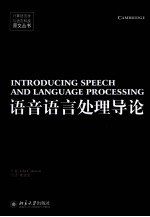图书介绍
语音语言处理导论【2025|PDF下载-Epub版本|mobi电子书|kindle百度云盘下载】

- (英)克勒曼著 著
- 出版社: 北京市:北京大学出版社
- ISBN:9787301171530
- 出版时间:2010
- 标注页数:301页
- 文件大小:72MB
- 文件页数:329页
- 主题词:自然语言处理-高等学校-教材-英文
PDF下载
下载说明
语音语言处理导论PDF格式电子书版下载
下载的文件为RAR压缩包。需要使用解压软件进行解压得到PDF格式图书。建议使用BT下载工具Free Download Manager进行下载,简称FDM(免费,没有广告,支持多平台)。本站资源全部打包为BT种子。所以需要使用专业的BT下载软件进行下载。如BitComet qBittorrent uTorrent等BT下载工具。迅雷目前由于本站不是热门资源。不推荐使用!后期资源热门了。安装了迅雷也可以迅雷进行下载!
(文件页数 要大于 标注页数,上中下等多册电子书除外)
注意:本站所有压缩包均有解压码: 点击下载压缩包解压工具
图书目录
1 Introduction1
1.1 About this book2
1.2 Purpose of this book2
1.3 Some reasons to use this book3
1.4 What's in the book(and what's not)5
1.5 Computational set-up needed for this book8
1.6 Computational skills that are necessary in order to use the book9
1.7 Free software suggestions10
1.8 Book structure10
2 Sounds and numbers13
2.1 Preparatory assignments14
2.2 Solutions21
2.3 Sampling24
2.4 Quantization24
2.5 The sampling theorem27
2.6 Generating a signal29
2.7 Numeric data types31
2.8 The program34
2.9 Structure of a loop35
2.10 Structure of an array37
2.11 Calculating the cosine values38
2.12 Structure of the program39
2.13 Writing the signal to a file40
Chapter summary43
Further Exercises43
Further reading46
3 Digital filters and resonators47
3.1 Operations on sequences of numbers48
3.2 A program for calculating RMS amplitude48
3.3 Filtering50
3.4 A program for calculating running means of 452
3.5 Smoothing over a longer time-window54
3.6 Avoiding the need for long window54
3.7 IIR filters in C61
3.8 Structure of the Klatt formant synthesizer62
Chapter summary68
Exercises68
Further reading69
4 Frequency analysis and linear predictive coding71
4.1 Spectral analysis72
4.2 Spectral analysis in C72
4.3 Cepstral analysis79
4.4 Computation of the cepstrum in C80
4.5 Pitch tracking using cepstral analysis83
4.6 Voicing detection86
4.7 f0 estimation by the autocorrelation method90
4.8 Linear predictive coding95
4.9 C programs for LPC analysis and resynthesis100
4.10 Trying it out106
4.11 Applications of LPC106
Chapter Summary109
Further exercises109
Further reading110
5 Finite-state machines111
5.1 Some simple examples112
5.2 A more serious example113
5.3 Deterministic and non-deterministic automata116
5.4 Implementation in Prolog118
5.5 Prolog's processing strategy and the treatment of variables129
5.6 Generating strings132
5.7 Three possibly useful applications of that idea134
5.8 Another approach to describing finite-state machines135
5.9 Self-loops137
5.10 Finite-state transducers(FSTs)139
5.11 Using finite-state transducers to relate speech to phonemes144
5.12 Finite-state phonology149
5.13 Finite-state syntactic processing153
Chapter summary156
Further exercises156
Further reading156
6 Introduction to speech recognition techniques157
6.1 Architectures for speech recognition158
6.2 The pattern-recognition approach166
6.3 Dynamic time warping168
6.4 Applications177
6.5 Sources of variability in speech181
Chapter summary182
Further reading183
7 Probabilistic finite-state models185
7.1 Introduction186
7.2 Indeterminacy:n-gram models for part-of-speech tagging187
7.3 Some probability theory for language modelling190
7.4 Markov models192
7.5 Trigram models198
7.6 Incompleteness of the training corpus202
7.7 Part-of-speech model calculations209
7.8 Using HMMs for speech recognition210
7.9 Chomsky's objections to Markov models and some rejoinders213
Chapter summary219
Further reading219
8 Parsing221
8.1 Introduction222
8.2 A demo222
8.3 'Intuitive'parsing223
8.4 Recursive descent parsing225
8.5 The simplest parsing program232
8.6 Difference lists233
8.7 Generating a parse tree236
8.8 Syllabification238
8.9 Other parsing algorithms242
8.10 Chart parsing242
8.11 Depth-first vs.breadth-first search245
8.12 Deterministic parsing,Marcus parsing and minimal commitment parsing246
8.13 Parallel parsing249
Chapter summary249
Further reading250
9 Using probabilistic grammars251
9.1 Motivations252
9.2 Probabilistic context-free grammars256
9.3 Estimation of rule probabilities258
9.4 A practical example261
9.5 A limitation of probabilistic context-free grammars267
9.6 Tree adjoining grammars268
9.7 Data-oriented parsing271
Chapter Summary272
Conclusion and suggestions for further reading272
Appendix:The American Standard Code for Information Interchange(ASCII)275
Glossary277
References293
Index299
热门推荐
- 2117460.html
- 1901286.html
- 1343005.html
- 1593190.html
- 1830132.html
- 2144870.html
- 178523.html
- 169498.html
- 2437463.html
- 352932.html
- http://www.ickdjs.cc/book_2074248.html
- http://www.ickdjs.cc/book_2264396.html
- http://www.ickdjs.cc/book_3334343.html
- http://www.ickdjs.cc/book_1088887.html
- http://www.ickdjs.cc/book_3225558.html
- http://www.ickdjs.cc/book_1917186.html
- http://www.ickdjs.cc/book_3712965.html
- http://www.ickdjs.cc/book_1376648.html
- http://www.ickdjs.cc/book_78983.html
- http://www.ickdjs.cc/book_3615306.html